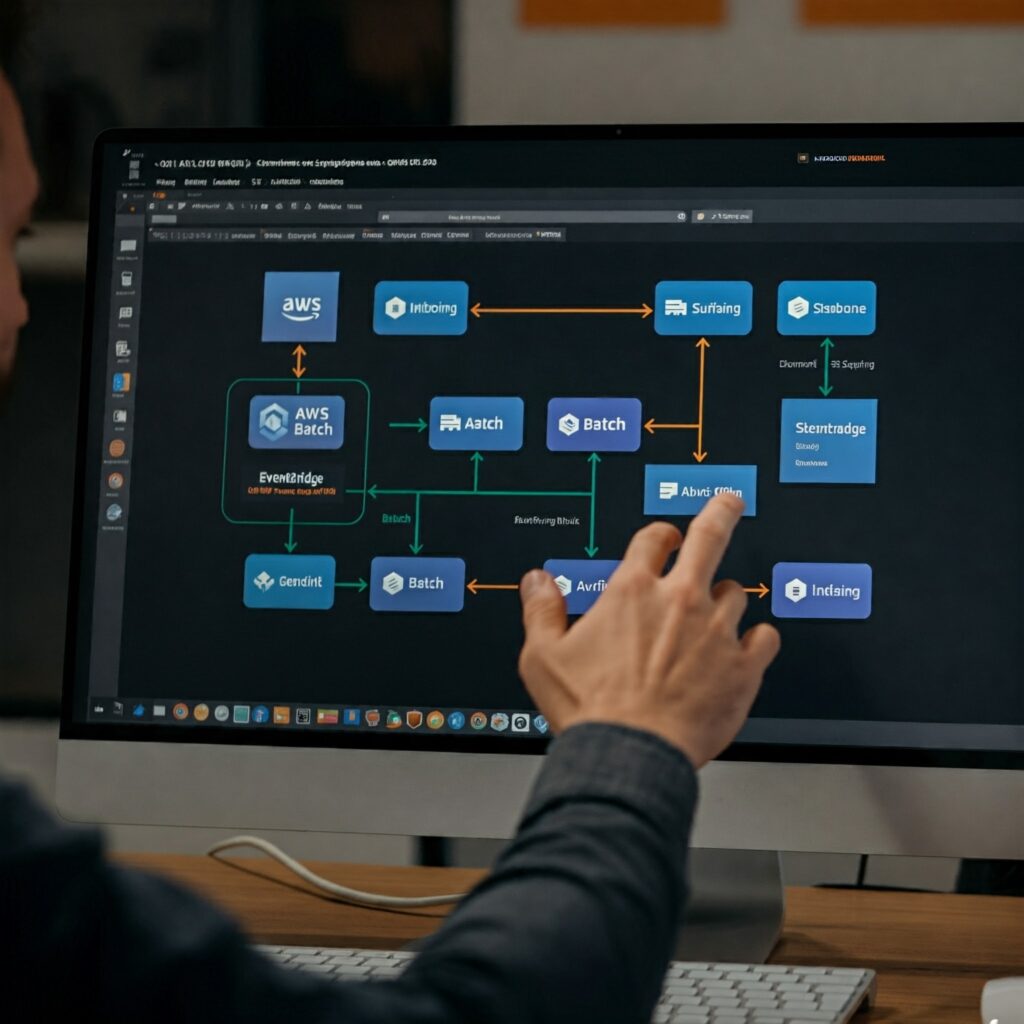
Selecting the right service for your workflow can often be challenging when building on AWS. You might think of it as choosing between two powerful tools in your toolbox: Amazon EventBridge and AWS Batch. While both have robust functionalities, they cater to different types of tasks. Knowing when to use each and how to combine them can make all the difference in building efficient, scalable applications.
Let’s look into each service, understand their unique roles, and explore practical scenarios where one outshines the other.
Amazon EventBridge: Real-Time reactions in action
Imagine Amazon EventBridge as a highly efficient “event router” for your system. In EventBridge, everything is an event, from user actions to system-generated notifications. This service shines when you need instant, real-time responses across multiple AWS services.
For instance, let’s consider a modern e-commerce platform. When a customer makes a purchase, EventBridge steps in to orchestrate the sequence of actions: it updates the inventory in DynamoDB, sends an email notification via SES (Simple Email Service), records analytics data in Redshift, and notifies third-party shipping services. All these tasks happen simultaneously, without delays. EventBridge acts as a conductor, keeping everything in sync in real-time.
Why EventBridge?
EventBridge is especially powerful for real-time processing, integration of different services, and flexible routing of events. When your system is composed of microservices or serverless components, EventBridge provides the glue to hold them together. It has built-in integrations with over 20 AWS services and supports custom SaaS applications. And thanks to “event schemas”, essentially standardized formats for different types of events, you can ensure consistent communication across diverse components.
To simplify: EventBridge excels in fast, lightweight operations. It’s the ideal choice when your priority is speed and responsiveness, and when you’re dealing with workflows that require instant reactions and coordinated actions.
AWS Batch: Powering through heavy lifting with batch processing
If EventBridge is your “quick response” tool, AWS Batch is your “muscle.” AWS Batch specializes in executing computationally intensive jobs that can take longer to complete. Imagine a factory floor filled with machinery working on heavy-duty tasks. AWS Batch is designed to handle these large, sometimes complex processes in an organized, efficient way.
Let’s look at data science or machine learning workloads as an example. Suppose you need to process large datasets or train models that take hours, sometimes even days, to complete. AWS Batch allows you to allocate exactly the resources you need, whether that means using more powerful CPUs or accessing GPU instances. Batch jobs can run on EC2 instances or Fargate, enabling flexibility and resource optimization.
Array Jobs: Maximizing Throughput
One of the most powerful features in AWS Batch is Array Jobs. Think of Array Jobs as a way to break down massive tasks into hundreds or thousands of smaller tasks, each working on a piece of the overall puzzle. This is especially useful in fields like genomics, where each gene sequence needs to be analyzed separately, or in video rendering, where each frame can be processed in parallel. Array Jobs allow all these smaller tasks to run at the same time, significantly speeding up the entire process.
In short, AWS Batch is ideal for heavy-duty computations, data-heavy processes, and tasks that can run in parallel. It’s the go-to choice when you need a high level of control over computational resources and are dealing with workflows that aren’t as time-sensitive but are resource-intensive.
When should You use each?
Use EventBridge when:
- Real-Time monitoring: EventBridge excels in event-driven architectures where immediate responses are critical, like monitoring applications in real-time.
- Serverless integration: If your architecture relies on serverless components (such as AWS Lambda), EventBridge provides the ideal connectivity.
- Complex routing needs: The service’s routing rules let you direct events based on content, scheduling, and custom patterns, perfect for sophisticated integrations.
- API integrations: EventBridge simplifies B2B interactions by acting as a “contract” between systems, making it easy to exchange real-time updates without directly managing API dependencies.
Use AWS Batch when:
- High computational demand: For tasks like data processing, machine learning, and scientific simulations, Batch allows access to specialized resources, including EC2 instances and GPUs.
- Large-Scale data processing: Array Jobs enables AWS Batch to break down and process enormous datasets simultaneously, perfect for fields that handle large volumes of data.
- Asynchronous or Background processing: Tasks that don’t require immediate responses, like video processing or data analysis, are best suited to Batch’s queue-based setup.
Hybrid scenarios: Using EventBridge and AWS Batch together
In some cases, EventBridge and Batch can complement each other to form a hybrid approach. Imagine you have an image-processing pipeline for a photography website:
- Image upload: EventBridge receives the image upload event and triggers a validation process to check the file type and size.
- Processing trigger: If the image meets requirements, EventBridge kicks off an AWS Batch job to generate multiple versions (like thumbnails and high-resolution images).
- Parallel processing with Array Jobs: AWS Batch processes each image version as an Array Job, optimizing performance and speed.
- Event notification: When Batch completes the task, EventBridge routes a completion notification to other parts of the system (e.g., updating the image gallery).
In this scenario, EventBridge handles the quick actions and routing, while Batch takes care of the intensive processing. Combining both services allows you to leverage real-time responsiveness and high computational power, meeting the needs of diverse workflows efficiently.
Choosing the right tool for the job
Selecting between Amazon EventBridge and AWS Batch boils down to the nature of your task:
- For real-time event handling and multi-service integrations, EventBridge is your best choice. It’s agile, responsive, and designed for systems that need to react immediately to changes.
- For resource-intensive processing and background jobs, AWS Batch is unbeatable. With fine-grained control over compute resources, it’s tailor-made for workflows that require significant computational power.
- In cases that demand both real-time responses and heavy processing, don’t hesitate to use both services in tandem. A hybrid approach lets you harness the strengths of each service, optimizing your architecture for efficiency, speed, and scalability.
In the end, each service has unique strengths tailored for specific workloads. With a clear understanding of what each offers, you can design workflows that are not only optimized but also built to handle the demands of modern applications in AWS.


